Archive for the 'Animation' Category
What does a Water Horse sound like?
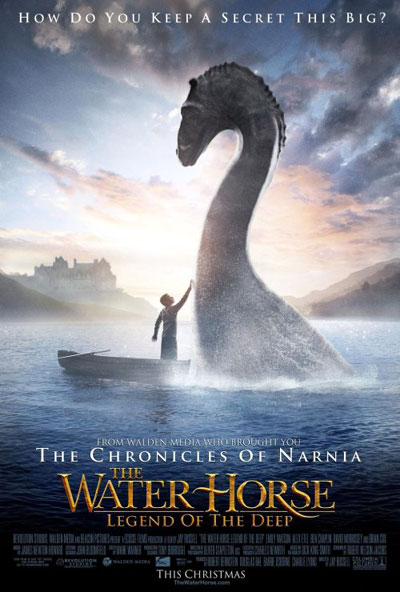
Kristin here—
Sentimental Journey
Regular readers of this blog will recall that David and I spent this past May in New Zealand, as Hood Fellows at the University of Auckland.
I did not have much of an excuse to go back to Wellington during our sojourn, but I decided to go for a few days anyway. It’s my favorite city in New Zealand, partly because I have so many memories of exciting events there and partly because it’s an attractive place in itself. Once my lecturing duties in Auckland were done, I took a train, the Overlander, that runs much of the length of the North Island. It’s a 12-hour ride through some very spectacular scenery (including Mount Doom, aka Mount Ngaurhoe; check it out on Google Earth at 39˚ 9’ 25.58” S 175˚ 37’ 57.89” E) and dizzying viaducts over deep gorges.
I was in Wellington for three days, staying where I had stayed on my previous three visits—the Victoria Court Motor Lodge. I originally chose it on the recommendation of Melissa Booth, a publicist on The Lord of the Rings, who had kindly acted as my point person for the first trip. During this year’s stay I had meals with a couple of people I had interviewed who also became friends. Judy Alley was the merchandising coordinator for Rings and King Kong and now works in publicity at Weta Digital. Given my interest in the franchise aspects of Rings, interviews with Judy had explained a lot about the nuts and bolts of coordinating with licensees. Erica Challis, co-founder of TheOneRing.net, had moved to Wellington since I interviewed her in Auckland. We snatched a quick dinner before she went to play French horn in a rehearsal for Swan Lake.
I also finally got to visit Te Papa, the national museum. It’s one of the main destinations for visitors, yet I had never gone through it. I felt it was rude to do that with my cell phone turned on. Sort of like keeping it on in a movie theater. But when I was trying to juggle appointments to interview people, I didn’t dare turn it off. It was worth missing some tourist opportunities, though, since every now and then that phone did ring, sometimes with good news.
For instance, on my first visit in 2003, a week after I had requested permission to watch Peter Jackson supervising the sound mixing on The Return of the King, I got a call at 7:45 pm on a Friday night telling me I could do so the next day. (If you hope to be a director’s or producer’s assistant, be prepared for long hours.) When I showed up, it turned out he and the sound editors were working on the Shelob sequence. Sometimes it pays to sit by the phone.
Park Road Post
During my Wellington visit, I learned from Barrie Osborne that coincidentally a film he is producing was in the sound-mixing phase, and I was invited to come and sit in for a day. Barrie is an American, but he produced The Matrix in Sydney and spent a long time in New Zealand producing all three parts of Rings. Like so many people who came from abroad to work on the trilogy, Barrie fell in love with the place. Now he lives there part-time and works on a range of Australasian projects, including executive producing The World’s Fastest Indian, a Kiwi film, and Little Fish, an Australian drama. (I saw these back-to-back at the American Film Market in 2005, going from the upbeat crowd-pleaser Indian to Fish, a drama about heroin addicts with great performances from Cate Blanchett and Hugo Weaving—both worth a look if you missed them on their brief American releases.) He also championed The Frodo Franchise from the start, and the book probably wouldn’t exist now without his help.
The film he was finishing up was The Water Horse: Legend of the Deep, an adaptation of a popular children’s fantasy novel by Dick King-Smith. It will be released on Christmas Day and has a PG rating.
The mixing was taking place in Studio 2 of Park Road Post, the same place where I had watched Peter supervising the Shelob scene.
Park Road Post (formerly The Film Unit) is a state-of-the-art post-production facility that started moving into its new building gradually, starting in the summer of 2003. At that point only the sound studios and the offices along the corridor outside them were finished. A segment about 19 minutes into the “Soundscapes of Middle-earth” supplement on the extended-version DVD of Return shows the facility as it was then.
My first interview with Barrie was in one of those offices, with considerable construction noise right outside the window. Fortunately my microphone was directional enough that it didn’t overwhelm our conversation. (That office is seen in the “End of All Things” supplement on the same disk.)
By my third visit to Park Road Post, in late 2004, the editing rooms and the huge, beautiful front lobby had been finished, the garden in the center courtyard was being installed, and the processing laboratories were being built. Now the whole thing is finished, with a strange juxtaposition of beautiful modern design in the front and big windowless concrete buildings at the rear.
Park Road itself is a street in the Wellington suburb of Miramar, lined in one section by small houses and then by rows of undistinguished warehouses and small industrial buildings. Next door is the large California Garden Centre, a round, orange building. Gazebos and garden swings are displayed right up against the walls of the sound studios.
Walking from this mundane environment into Park Road Post is a disorienting experience. Suddenly one is in a modern building with a design heavily influenced by Frank Lloyd Wright. Natural wood, fireplaces, stained glass windows, cushy leather sofas. It’s a building that one doesn’t want to leave. It has almost an other-worldly quality, which is perhaps not surprising given that it was designed by Dan Hennah, the art director of Rings and Kong.
Making the place as attractive as possible was part of the brief that Peter and partner Fran Walsh handed Dan. As he told me, “It was partly about getting it technically correct and partly about creating an environment that, while being technically correct, was still human and homely and all those things—the comfort zone. So that you actually felt like getting up and going in there in the morning—rather than thinking, ‘Oh, God, I’ve got to go into that bloody hole again!’”
By now the ironic story has become famous. A 17-year-old Peter Jackson, aspiring to be a filmmaker, left school and applied for a job at the Film Unit back in the late 1980s. He was turned down, so he worked as a photo-engraver at a newspaper instead. Eventually he got enough backing to quit and finish Bad Taste (1987), his long-gestating first feature. A little over ten years later he bought the Film Unit, then housed in what he described to me as “a sort of ‘Soviet bloc’ feeling place.” During my first visit in 2003, the editing and lab facilities were still there, in a dreary-looking industrial complex out in the distant suburb of Lower Hutt.
Tracking The Water Horse
At the Water Horse sound mixing director Jay Russell was present, though he slipped out at intervals for meetings. As I was about to leave, he remarked that watching sound mixing is like watching paint dry. That’s what everyone says about mixing, but I find it fascinating.
Back in the late 1970s when David and I had the opportunity to spend about half an hour watching the great Walter Murch working on a scene for Apocalypse Now, it was a slow process. Mixing was done on film, so every repetition involved a pause for rewinding, threading the projector, and so on. Now, with high quality digital images being projected on the studio screen, mixers can almost instantly go back to the beginning of a segment by sliding a control handle or move to a different scene by typing in a file number. As a result, there may be many repetitions of the same series of shots, but there’s not that much down time.
The repetition isn’t boring, either, since you can listen for the tiny changes that the mixers make between projections of the scene. (See David’s account of his experiences watching James Mangold’s team mixing sound for 3:10 to Yuma.) There may also be pauses, but usually they’re for discussions among the sound team members. Some of this was just too technical for me to grasp, but what I could follow was fascinating.
That particular day came fairly late in the overall process. Jay was there because the work on the sound was close to finished. The team was concentrating on the final mix of reel 1. It was quite a contrast to the footage I had seen being mixed for Return. In that case a lot of unrendered effects shots were still in the edit, and many scenes hadn’t been locked down yet. Shots of Gollum often just showed him as a figure made up of silvery bands against a black background, and in some cases there was only a title describing the nature of the scene—a close-up of Treebeard looking left, for example. (Again, the DVD bonus chapter “The Soundscapes of Middle-earth” shows some vivid examples of the process.) In the case of The Water Horse, all the footage was finished, and the editing had been completed.
A lot of what goes on at this late stage is tweaking individual tracks. Even though there’s a full mix by this point, the team frequently take out all the tracks except one, so that a bustling city street scene may have densely layered traffic sounds and a musical track during one run-through and only a couple of characters’ footsteps in the next.
As with many films, some musical instruments were on separate tracks. Jay could ask for a drum beat to be turned up to provide a more distinct rhythm to a scene or for certain instruments to be favored so as to enhance the atmosphere of the Scottish setting.
Some of the people present had worked on Rings as well, so I knew a few of them already. It was great to see Rose Dority, post-production supervisor, again. Since my book isn’t really a making-of study, I hadn’t interviewed her, but she had been very hospitable. I also recognized Dave Whitehead, the supervising sound editor, who seems to have worked on half the films made in New Zealand over the past 13 years.
At lunch I got talking with Dave, and he told an anecdote about how some of the war chants of the Easterling attackers during the Battle of the Pelennor in The Return of the King were done. The sound department couldn’t use English, of course, and no texts had been provided. One tactic the recorders and mixers resorted to was spelling the names of their children, friends, and colleagues backwards. In fact I had been present the day those chants were being synchronized and remembered vividly how at the time Dave had explained that “Revilo!”—which sounded very aggressive when shouted in unison by male voices—was based on his son’s name, Oliver. Rose got into the mix as well, as “Ésor!” In the final mix, those chants are not really distinguishable as individual words, being parts of a dense mix of battlefield noises. Still, it was fun knowing that they were there.
The Water Horse mixing went on until mid-afternoon, when a group of people came into the studio for a run-through of the first reel. By that point I was pretty familiar with all the footage and could concentrate on the soundtrack rather than figuring out the plot from the scenes shown out of order up to that point.
Once the screening ended, Barrie asked various people if they had noticed anything that might need changing. Rather to my surprise he included me. Fortunately, rather than sitting there saying, “Ummmm … no,” I did have a suggestion about one sound that was slightly too loud and distracting during a suspenseful moment. That got duly noted down with the other comments and fixed during the final changes. That was an unexpected treat!
The Water Horse is a story of a Scottish boy who finds a strange egg that hatches into a little creature that will grow into the Loch Ness Monster. In the reel I saw, the landscapes were beautiful, a smooth mixture of footage shot in Scotland and in New Zealand. With both Weta Workshop and Weta Digital providing special effects, it naturally has high production values–including a carefully mixed soundtrack. It’s a children’s film, but from what I saw of it, parents will enjoy it as well. (The favorable Variety review is here.)
It’s a production by Walden, which specializes in family-friendly projects. The company seems to like New Zealand, given that much of the first Chronicles of Narnia film and part of the second were shot there.
Bwana Beowulf
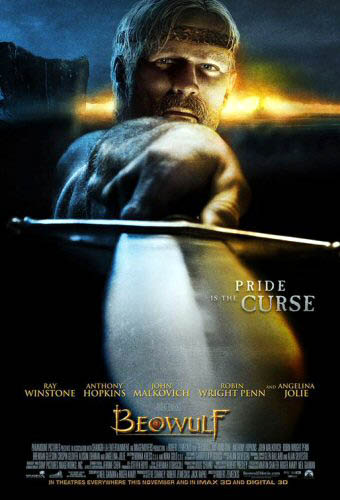
KT: I do not understand Beowulf. I don’t understand why the director who made one of the great modern Hollywood films, Back to the Future, and several very good ones, including Who Framed Roger Rabbit? and Cast Away, now has this fixation with creating nearly photo-realistic 3D digital images.
DB: I think that on the whole Zemeckis’ films have become weaker since Bob Gale stopped working with him. I like the sentiment of I Wanna Hold Your Hand and the crass misanthropy of Used Cars, and I think the Back to the Future trilogy mixes both in clever ways. But now almost every Zemeckis film seems to be less about telling a story than solving a technical problem. How to best merge cartoons and humans (Roger Rabbit)? How to push the edge of spfx (Death Becomes Her, Forrest Gump, Contact)? How to make half a movie showing only one character (Cast Away)? There’s a stunting aspect to this line of work, though I grant that it can lead to technical breakthroughs, as in Gump.
KT: I also don’t understand why most of the supposedly state-of-the-art effects technology looks distinctly cruder than the CGI in The Lord of the Rings, the first part of which came out six years ago. I don’t understand why studios that are trying to push 3D to a broad audience make a film with silly action aimed at teenage boys. That’s an OK strategy when you’ve got a $30 million horror film, but a budget of $150 million demands a lot broader appeal.
DB: And the evidence so far indicates Beowulf doesn’t have that appeal. The obvious comparison is 300, from earlier this year. According to Box Office Mojo it cost about $65 million to make, but it reaped $70 million domestically in its first weekend and wound up with $450 million theatrically worldwide. Beowulf grossed $27.5 million in its first US weekend and currently sits at about $146 million worldwide. I’d think that this has to be a disappointment. Recall too that the Imax screenings have higher ticket prices, so there are fewer eyeballs taking in Angelina Jolie’s pumps, braid, and upper respiratory area.
In addition, sources suggest that a 3-D version of Beowulf will not be available on DVD, so the sell-through takings—the real source of studio profit—may be significantly smaller than average.
KT: It seems to me that the people who are pushing 3-D so hard and hoping for it to become standard in filmmaking are forcing it on the public too soon. It’s still fiendishly difficult and expensive to shoot live action material in digital 3-D, so most projects are animated. One approach, taken in Beowulf, is to motion-capture real people and animate the characters to make them appear as much like the real people as possible. The problem is that they still have a weird look about them, like moving dolls. People have complained about the dead-eyed gaze of the characters in The Polar Express, and though there’s apparently been an improvement between the two films, the eyes don’t always look as though they’re focusing on anything. It can be done, though; the extended-edition Lord of the Rings DVD supplements about Gollum show how much effort went into making his eyes have a realistic sheen and flicker.
I was also struck by how clunky some of the animation looked. Beowulf is supposedly state of the art, and it certainly had the budget of a major CGI film. Yet some of the rendering and motion-capture was distractingly crude. I noticed that particularly on the horses. Their coats looked pre-Monsters, Inc., and their movements at times reminded me of kids rocking plastic toys back and forth. I suspect this effect had something to do with a lack of believable musculature. If you look at the way the cave troll was done in The Lord of the Rings: The Fellowship of the Ring (again, demonstrated in the DVD supplements), there was a specific program to simulate the way muscles move on skeletons, even the skeletons of imaginary creatures. Now, six years later, we see these things that look like hobby-horses—and that all run alike.
The backgrounds were often strange as well, simple and flat-looking, like painted backdrops. There were some exceptions, with the seascapes and rocky crags pretty realistically done. But just plain hillsides and groups of tents and so on looked almost sketchy in comparison with the moving figures, and I noticed that at times some fog would be put in, presumably to cover that problem up. There certainly was some very good animation as well, most notably the dragon, but there was no consistency of visual style.
DB: I’d go farther and say that 3-D hasn’t improved significantly since the 1950s. It ought to work: just replicate the eyes’ binocular disparity by setting two cameras at the proper interval or, now, by manipulating perspective with software. Yet in films 3-D has always looked weirdly wrong. It creates a cardboardy effect, capturing surfaces but not volumes. Real objects in depth have bulk, but in these movies, objects are just thin planes, slices of space set at different distances from us. If our ancestors had seen the world the way it looks in these movies, they probably wouldn’t have left many descendants.
It would take a perceptual psychologist to explain why 3-D looks fake. Whatever the cause, I’d speculate that good old 2-D cinema is better at suggesting volumes exactly because the cues to depth are less specific and so we can fill in the somewhat ambiguous array.
By the way, in watching a 3-D movie I seem to go through stages. First, there’s some adjustment to this very weird stimulus: I can’t easily focus on the whole image and movement seems excessively fuzzy. Then adaptation settles in and I can see the 2 ¼-D image pretty well. But adaptation carries me further and by the end of the movie I seem to see the image as less dimensional and more simply 2-D; the effects aren’t as striking. But maybe this is just me.
Back to the Future, or at least 1954
DB: I’d like to think about it from a historical perspective for a while. The industry seems to be repeating a cycle of efforts that took place in 1952-1954. The American box office plunged after 1947 as people strayed to other entertainments, including TV, and so the industry tried to woo them back with some new technology. Today, as viewers migrate to videogames, the Internet, and movies on portable devices, how can theatres woo their customers? Answer: Offer spectacle they can’t get at home.
Beowulf brings together at least three factors that eerily remind me of the early 1950s.
(1) Obviously, 3-D. The first successful 3-D feature era was Bwana Devil, released in November of 1952. It was an uninspired B movie, but it launched the brief 3-D craze. Columbia, Warners, and other studios made major pictures in the format, most notably House of Wax (1953). But costs of shooting and screening 3-D were high, with many technical glitches, and apart from novelty value, the process didn’t guarantee a big audience. The fad ended in spring of 1954, when all studios stopped making films in the format.
The process has been sporadically revived, notably in the 1980s (Comin’ at Ya, Jaws 3-D) and once more it fizzled. So, ignoring the lessons of history and chanting the mantra that Digital Changes Everything, we try it again.
(2) Big, big screens. In September of 1952, Cinerama burst on the scene with its huge tripartite screen and multitrack sound. It attracted plenty of viewers, but it could be used only in purpose-built venues. Like 3-D, its technology could never replace ordinary 35mm as the industry standard. The contemporary parallel is Imax, which though very impressive will not replace orthodox multiplex screens—too expensive to install and maintain, pricy tickets. Like 3-D, it’s a novelty. (1)
(3) The sword-and-sandal costume epic. It’s a long-running genre, but it got significantly revived in the late 1940s. It was a logical input for the new technologies of widescreen—not Cinerama but more practical offshoots that gained more general usage.
From the standard-format Samson and Delilah (1949), David and Bathsheba (1951), and Quo Vadis (1951) it was a short step to The Robe (1953) and The Egyptian (1954) in CinemaScope, The Ten Commandments (1956) in VistaVision, The Vikings (1958) in Technirama, Hercules (1959) in Dyaliscope, Solomon and Sheba (1959) and Spartacus (1960) in Super Technirama 70, and Ben-Hur (1959) in anamorphic 70mm Panavision. It is, incidentally, a pretty dire genre; the peplum might be the only genre that has given us no great films since Cabiria (1914) and Intolerance (1916).
In parallel fashion, the revival of the beefcake warrior film with Gladiator (2000) coincided with innovations in CGI and thus furnished new forms of spectacle for Troy (2004), Kingdom of Heaven (2005), and 300 (2007). This trend paved the way for Beowulf. When screens get bigger, Hollywood hankers for crowds, oiled biceps, big swords, and nubile ladies in filmy clothes. Not to mention soundtracks with pounding drums, wailing sopranos, and choirs chanting dead or made-up languages. And the conviction that Greeks, Romans, and those other ancient folks spoke with British accents. The innovation of Beowulf is to turn a Nordic hero into a Cockney pub brawler.
In other words, it’s 1954 again. So if we ask, Will it all last? I’m inclined to answer, Did 1954?
KT: Yes, the studios see the new technology as one more way to lure people away from their computers and game consoles and into the theaters. Maybe that will work to some extent. There’s no doubt that a lot of the people who have seen Beowulf have praised it as a fun experience and as having effectively immersive 3-D effects. I’m surprised at how many positive comments there are on Rotten Tomatoes, where the average score from both amateur and professional reviewers is 6.5 out of 10. That’s not exactly dazzling, but it’s a lot higher than I would give it.
Even so, the film hasn’t lured all that many people away from their other activities. You’ve mentioned that Beowulf hasn’t done all that well at the box-office. It did much better in theaters that showed it in 3-D. If it hadn’t been for the 3-D gimmickry, it would probably have been dead in the water from the start. And if 3-D effects remain on the level of gimmickry, they will soon wear out their welcome. Presumably the people who have been going to Beowulf are to a considerable extent those who are already interested in 3-D, and I can’t believe there are huge numbers of people really passionate about the idea of someday being able to watch lots of films in 3-D. If more films like Beowulf come out—ludicrous, bombastic action with distracting animation problems—they’re not likely to make the prospect any more attractive.
Eventually somebody—James Cameron or Peter Jackson, perhaps—will make the first great 3D film, and then maybe the passion will spread.
3-D in 2-D
DB: I’m doubtful that there will ever be a great 3-D film, and especially from those directors. But one last historical note.
I think that ordinary mainstream cinema has been setting us up for the flashiest 3-D flourishes for some time. One of the goals of the Speilberg-Lucas spearhead was to amp up physical action, to make it more kinetic, and this often showed up as in-your-face depth. Spielberg used a lot of deep-focus effects to create a punchy, almost comic-book look, and who can forget the opening shot of Star Wars, with that spacecraft arousing gasps by simply going on into depth forever? Seeing the movie in 70mm on release, I was struck by how the last sequence of Luke’s attack mission was maniacally concerned with driving our eye along the fast track of central perspective. Did it foreshadow the tunnel vision of videogame action?
In any case, I think that aggressive thrusting in and out of the frame was integral to the style of the new blockbuster. Since then, our eyes have been assaulted by plenty of would-be 3-D effects in 2-D. In Rennie Harlan’s Driven (2001), the crashing race cars spray us with fragments.
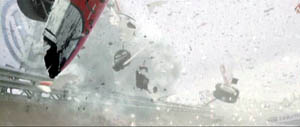
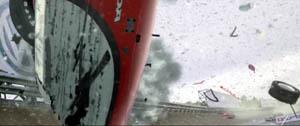
Jackson is definitely in the Spielberg line, favoring steep depth and big foreground elements. In King Kong, the primeval creatures lunge out at us, heave violently across the frame, and fling their victims into our laps.
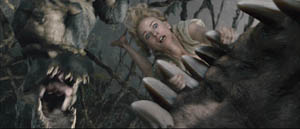
Such shock-and-awe shots recall American comic-book graphics. These affinities are at the center of 300, as we’d expect. For example, a cracking whip curls out at us in slow motion, like a two-panel series.
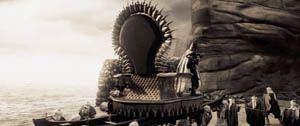
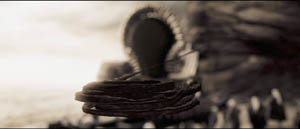
Beowulf draws on this thrusting imagery, but inevitably it doesn’t seem fresh because so many 2-D films have already used it. Maybe the most original device is having the camera pull swiftly back and back and back, letting new layers of foreground pop in and shrink away. This is viscerally arousing in 3-D, but aren’t there precedents for it—in the Rings, in animated films, or some such?
Zemeckis tries to transpose into 3-D the style of what I’ve called, in The Way Hollywood Tells It, intensified continuity. This style favors rapid cutting, many close views, extreme lens lengths, and lots of camera movement. I found Zemeckis’ restless camerawork even more distracting than in 2-D. So I’m wondering if current stylistic conventions can simply be transposed to 3-D, or do directors have to be more imaginative and make fresher choices?
KT: That pull-back effect may be viscerally arousing, but in Beowulf it was usually pretty gratuitous and, for me at least, it called attention to itself in a way that was often risible. I don’t think there’s anything in Rings as crude as the shots in Beowulf that you’re talking about. In the opening scene of the latter, in the mead-hall, the camera zips into the upper part of the room, with rafters, chains, torches, and even rats whizzing in from the sides of the frame. None of that contributes to the narrative.
The flashiest backward camera movement, or simulated camera movement, I can think of in Rings is the one in the Two Towers scene where Saruman exhorts his army of ten thousand Uruk-hai to battle. The final shot is a rapid track backward through the ranks of soldiers holding flag poles. The point is to stress the enormous numbers of soldiers. There’s no gratuitous thrusting-in of set elements from the sides, just the cumulative effect of so many similar figures. The simulated camera also at one point “bumps” one of the flagpoles, causing it to wobble, but I take it that that’s an attempt to add a certain odd realism to the “camera” movement, not a knowing nudge to the audience. In Rings, the virtual camera usually follows action rather than moving independently through space. It tends to go forward or obliquely rather than backward.
As to transferring classical Hollywood style to 3-D or finding a whole new set of conventions to fit 3-D, Beowulf offers an object lesson. It uses a combination of the two. At times we have conventional conversations using shot/reverse shot, and at other times we have the swoopy-glidey style you described, with the camera zipping around the space and trying to see it from every angle within a few seconds.
The odd thing is, neither one works. The very close shot/reverse shot views of the digital characters make them look unnatural and emphasizes the not infrequent failure of their eyes to connect with each other. The swoop-glidey camera movements are silly and don’t stick to the narrative.
I’m not optimistic enough to think that directors can come up with a whole set of “fresher stylistic choices” to make 3-D work. Maybe Sergei Eisenstein, with his meticulous attention to every aspect of such topics, could have thought the issue through, but his solution would probably not be viable for the Hollywood studios. My own thought is that directors working in 3-D should probably stick to classical Hollywood style and avoid flashy stylistic effects. So far, the more blatantly 3-D something looks on the screen, the less it makes 3-D seem like something we want to watch on a regular basis. Think of the best films of this year: Zodiac, The Assassination of Jesse James by the Coward Robert Ford, Ratatouille, Across the Universe, and so on. Would any of them be better in 3-D? Probably not.
Plus, I don’t like watching movies through something. Movies should just be the screen and you. The 3-D glasses are definitely better now than in the earliest days of the cardboard, red/green versions. Still, the Imax glasses we used in watching Beowulf were heavy enough to leave a groove on my nose. Make the mistake of touching the lenses, and you’ve got a blur on one half of your vision of the film. In short, I think that 3-D still has to prove itself, and Beowulf didn’t add any evidence.
(1) PS 9 December: DB: I originally added in regard to Imax: “It’s actually waning in popularity, except in newly emerging markets like China.” This disparaging comment was misleading. Yesterday I learned from Screen International that Imax recently signed a deal with AMC to install 100 systems in 33 US cities. Oops! Today Paul Alvarado Dykstra of Austin’s Villa Muse Studios kindly wrote to point out the Hollywood Reporter‘s coverage, which gives background on the costs of installing and maintaining an Imax facility.
I was, obscurely, thinking of the traditional Imax programming of travelogues and documentaries. I failed to register that these have been largely displaced by screenings of blockbuster features, catching fire in 2003 with The Matrix Reloaded and proving successful with The Polar Express and other titles. Imax is now largely an alternative venue for megapictures, and its seesawing financial performance may have been steadied by moving into the features market.
PS 26 December: Travel has delayed our timely linking, but we couldn’t neglect Mike Barrier’s in-depth critique of Beowulf here.
PPS 5 January 2008: Harvey Deneroff has a comprehensive and judicious discussion of the 3D situation here.
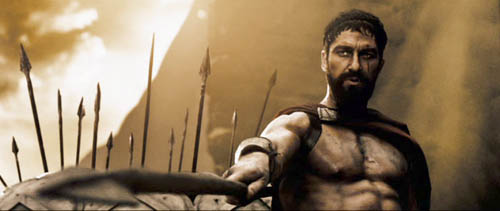
A turning point in digital projection?
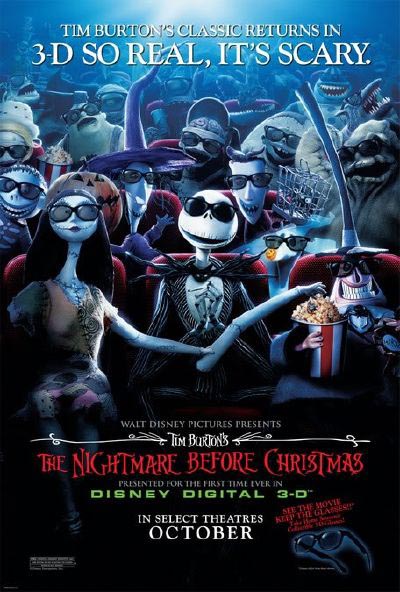
Kristin here–
This past Friday, October 19, marked an historic moment in the history of Madison movie-going. We got our first permanent digital projection set-up, and not just digital, but 3D. The first film to be presented there was Tim Burton’s The Nightmare before Christmas.
We’ve had several big changes in the local theater scene recently. In May the first purpose-built Sundance Cinemas art-film multiplex opened. Madison, I gather, is considered a pretty good moviegoing market for its size. A more modest two-screen theater, the Hilldale, was shut down and demolished. Not such a bad thing, since the Hilldale, a two-screen house, was not aging well. We now have two multiple-screen theaters showing nothing but art films, Westgate and Sundance, as well as the Orpheum theater, University of Wisconsin union, and the Communication Arts Department’s Cinematheque showing art films part-time. Overall the city has a total of something like 60 screens for a population of just over 200,000.
Film vs. Digital: The Film Scholar’s Perspective
As film historians, David and I like to work directly with films. This summer he posted an entry on the joys and possibilities of analyzing films on a flatbed editing table. We used to insist that all the frame enlargements we used to illustrate our books be from film. We acquired hundreds of trailers and patiently cut them up, mounting them in slide frames to use in lectures. Naturally they looked great. For older films, we went to archives and used special photographic equipment to capture frames. Eventually DVD technology got good enough that we had to admit frames captured from them could look as good on the pages of a textbook as reproductions from our slides or negatives. Now Film Art and our other books contain illustrations from a mixture of sources.
But obtaining images for illustrations is a very different thing from watching a movie projected digitally in a theater. The images from a strip of real film have a distinctive look to them. They convey a sense of life. It’s a subtle thing, but the minute grains that make up the blacks, whites, and colors in the frames shimmer slightly from frame to frame. (That’s why a freeze frame makes an image look suddenly grainy. There’s no play of the particles from frame to frame to overlap and create a richness.) Digital projection throws visual information on the screen far faster, eliminating the shimmer and creating instead a fixed-looking image.
So we’re not in a great hurry to see 35mm projection disappear, and we watch the growth of digital exhibition with both interest and some trepidation.
The Slow Progress of Digital Projection
Digital projection has been around for years now, but for most of those years we lovers of 35mm film could largely ignore it. The earliest digital screenings of films in theaters took place way back in 1998, with satellites beaming The Last Broadcast into the few American houses with the proper equipped. Every now and then other digital advances would be touted, but the installation of digital projection equipment around the world has been slow.
Some of the reasons for that slowness are obvious. As usual with such technological breakthroughs, there have been competing systems. There still are. The cost of such a projection system is around $150,000. Tell your theater-chain owner holding nine sites, each with ten screens, that he or she needs to make an expenditure of $13.5 million and see what the response is. Especially if that owner has fairly new, expensive 35mm projectors already installed. The theater owners have argued that the distributors should pay part of the costs. The distributors, naturally, want the exhibitors to pay.
Both groups would gain advantages from digital. Among those are savings in printing up thousands of copies of a given film, usually at over a thousand dollars apiece, and shipping the very heavy prints via overnight courier service. There would be no physical prints going through projector gates and suffering scratches and breakage.
Assuming theater owners will end up paying for most or all of the conversion, they would want to charge extra in order to make up the costs of the equipment. There are undoubtedly people who think digital is superior, and they would pay a higher admission price. A lot of moviegoers, however, couldn’t care less whether the moving image they see in the multiplex is coming out of a 35mm projector or a digital one—and they’re probably not about to pay a dollar or two more to go in the digital auditorium that’s playing The Bourne Ultimatum rather than the one with the old-fashioned 35mm system.
Until now, that is. Modifications of projection systems that allow for 3-D projection have finally given exhibitors a selling point that will get patrons into theaters at advanced prices. Our local multiplex that is showing Nightmare is charging two dollars more for it than for films on its other screens. Apparently people will pay. Nationwide this weekend Nightmare is estimated to make $5,245,000 in 564 theaters, for a per-screen average of $9,122. That’s the highest average in the top 25 films. In contrast, 30 Days of Night, the top grosser at $16 million, has a $5,604 per-screen average.
The question remains, will people remain willing to pay extra for 3-D once its novelty value wears off?
2007 is increasingly being touted as the year when digital installations have speeded up most radically. The conversion will still be a slow process, but for the first time it becomes plausible to think that in the not too distant future digital might kill off 35mm projection. In the October 13-14 issue of The Hollywood Reporter, Gregg Kilday, its editor, suggests that 2009 will be the breakthrough year for digital 3-D. Two major 3-D projects, DreamWorks’ animated Monsters vs. Aliens and James Cameron’s Avatar, will debut within a few months of each other. The real question, he says, is whether enough theaters will be outfitted with digital projection by then. With big theater chains now adopting the new technology, it seems quite possible. (See here for an excellent summary of the current situation of theater conversion and 3-D films in the pipeline.)
Alone with my 3D Glasses
As I was sitting at my desk last Wednesday afternoon, finishing up my David Cronenberg entry, I got a call from a friend of ours, Tim Romano. Tim is an expert projectionist, perhaps the best in town. He’s the one theaters often call on to test new equipment and screen the big blockbusters ahead of time to check for flaws. Not surprisingly, Tim was testing the new digital projector by running Nightmare over and over, as if for a regular day’s screenings, but without an audience. Tim suggested that I might want to drop in and catch a screening. Naturally I headed for we call Point, which is really the Marcus Point UltraScreen Cinema.
As the name suggests, Point is part of the Marcus Theatres Corporation’s chain of 47 theaters (594 screens), scattered across Wisconsin, Illinois, Minnesota, Ohio, North Dakota, and Iowa. Some of the chain’s other theaters will be getting digital projection installations as well. The name Marcus is a big one here in the Midwest, since The Marcus Corporation also owns or manages 20 hotels in the area. Its theater chain is the seventh largest in the country.
Arriving at Point, I received my 3-D glasses from the ticket seller, obtained my snack of choice (Junior Mints), and headed for what proved to be an otherwise empty auditorium. I had missed the opening, but having seen the film a couple of times, I figured that didn’t matter. I was here to see what digital 3-D looks like.
When we go to the movies, David and I usually sit in the center of rows three to five, depending on the size of the screen. This time I sat in row five, but I quickly found the edges of the eyepieces were not wide enough to take in the entire screen. There’s an aisle across the auditorium behind the fifth row, so I sat at the front of the upper section of the house, approximately row eight. That worked fine.
I’m not sure the glasses I had were the same kind that are being used for commercial screenings. Still, my impression is that if you’re used to being down front, sitting a bit further back works well for this film.
Nightmare was originally made on 35mm film using stop-motion to animate puppets. It was transformed into a 3-D film using technology from a company called Real D, which also has been the major player in the move to install digital projection equipment in theaters.
Tim wasn’t, however, projecting Nightmare on a Real D projection setup. Just recently Dolby has moved into digital projection in a big way, and the Point installation is part of its rollout of competing equipment. (For details and other cinema chains using Dolby, see here.) Dolby may have the edge, since its projector works with existing white screens, while Real D’s requires a special silver one.
Happily, the new polarized glasses work better than earlier models. My experience with the older glasses was that one’s eyes sometimes had to struggle to resolve the images onscreen into three dimensions, and one could end up with a headache by the end of the movie. Dolby’s digital 3-D system makes perception of the depth effects automatic and effortless.
Speaking of the glasses, I was amused to note that publicity for the film (see the poster above) shows the characters wearing what look very much like sunglasses. Most probably people still think of 3-D glasses as clunky and cumbersome. This is clearly an attempt to counter that image and make the glasses look cool, like the ones sported by characters in Men in Black or The Matrix.
The depth effect is definitely impressive, even in a retro-fitted film like Nightmare. Because it was not originally produced in 3-D, most of the depth appears to extend behind the screen. I remember seeing 3-D films made in the 1950s that strive to thrust objects out at the audience—most effectively in House of Wax when a carnival barker has a paddle-ball that he bounces directly toward the camera. I rather prefer the depth behind the screen to the depth in front, which tends to be distracting. Whatever the promoters say about people wanting to feel themselves in the movie, I would prefer not to have projectiles coming at my face or actors tumbling into my lap.
The movement of the characters was fine most of the time. I found that rapid action caused a ghosting, blurred effect that was quite different from the rock-steady three-dimentionality of static or slowly moving figures. That ghosting may simply be an artifact of the process of turning 2-D into 3-D, and perhaps films made in 3-D will not have it.
Then there’s the matter of grain and other qualities of 35mm film. Certainly one can’t object to the lack of dust and scratches. The absence of grain is a little disconcerting, but it’s really hard to judge in an animated film like this. Presumably, though, it’s not significantly different from 2-D digital projection, which I’ve never seen. I suppose I shall get used to it.
The Current Trend
So Nightmare provides only a limited indication of what the future holds.
Thus far animated films have made up the bulk of the digital 3-D films released. It’s much easier and cheaper to build 3-D into a CGI cartoon (e.g., Disney’s Meet the Robinsons) than to use it on the set of a live-action film. Indeed, the current generation of 3-D features that include actors have employed motion-capture technology. The proof of that pudding will come with Robert Zemekis’s Beowulf, due out November 16.
The real future of 3-D will depend on it attracting adult audiences, and that means that more live-action films will need to be made. That’s not happening now because the technology remains to expensive, cumbersome, and touchy to be easily used on set. The technology is bound to advance, though.
In the meantime, possibly we can expect that for the near future, digitally equipped auditoriums will be a little like Imax is now. A multiplex might have one Imax screen, but it would never put Imax in all its other theaters. Similarly, a theater owner might be willing to pay that $150,000 to convert one projection system in a multiplex, with digital 3D remaining a special attraction, one which people are willing to pay a little extra for.
If such a scenario is fulfilled, then we may see 35mm and digital share the multiplexes of the world for a long time. You wouldn’t hear me complaining.
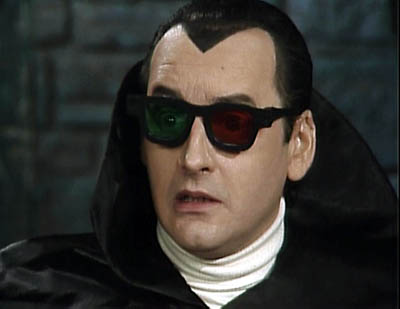
The magic number 30, give or take 4
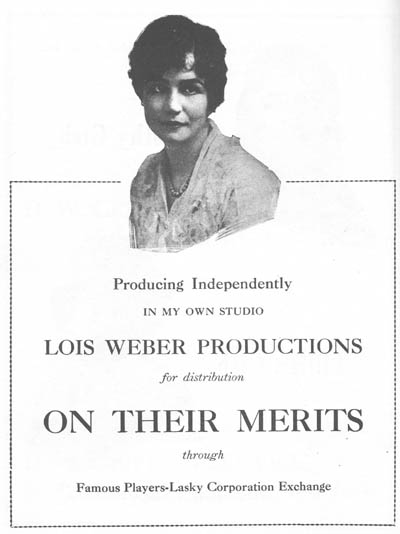
David here–
When I was teaching, students often came to my office hours with variants of this question. “I want to direct Hollywood movies. When should I start trying to get into the industry?”
My answer usually ran this way:
Your prospects are almost nil. It’s tremendously unlikely that you will become a professional director. You may wind up in some other branch of the industry, though. In any case, start now. Aim for summer internships while you’re in school, and try to get a job in LA immediately after graduation—preferably through a friend, a relative, a relative of a friend, or a friend of a relative.
My answer still seems reasonable, but recently I’ve begun to wonder if it holds up across history. Suppose we refocus our goggles on the macro scale. At what ages do most Hollywood directors make their first feature? If we can come up with a solid answer, it would be one instance in which studying film history can have very practical consequences.
No country for old men
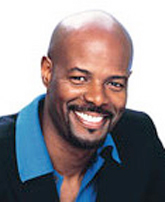
In any field, most people would expect to have their careers moving along by the time they hit their early thirties. But aspiring filmmakers may think that there’s a long period of preparation–working in a mailroom, sweating over screenplays–before they finally get to direct. Directing films is a top-of-the-heap role. Who would trust a young first-timer with a multimillion-dollar investment and authority over far more experienced performers and technicians?
Nearly everybody, actually.
Executives tend to be oldish and not fully aware of what the target movie audience likes. A few years ago a friend of mine, consulting for the studios, went to a meeting of suits and was told that all the new digital sampling and mixing software was purely an effort to steal music. He replied that there were legitimate creative uses of that technology. “For example?” one exec asked. My friend said, “Well, there’s Moby.” Nobody at the table knew who Moby was.
So hiring young people in touch with their peers’ tastes makes sense. Indeed, many of today’s top filmmakers started making features quite young. I haven’t made an exhaustive survey, but picking directors more or less at random yields some pretty interesting results.
Note: It’s hard to know how long a movie took to make, so I’ll use the release date as my benchmark. With the exceptions noted at the end, I haven’t checked people’s birthdays against day and month release dates. As a result, the ages of directors that I’ll be giving fall within a year of the releases. That works well enough to establish an approximate age range for a general tendency. And since it takes at least a year to get a project finished and released, we have to remember that most of these people started work on their first feature quite a bit earlier than is indicated by the age I give.
Start with directors who broke through in the 1990s and 2000s. Many were about 30 when their first features came out: Keenen Ivory Wyans (above; I’m Gonna Get You Sucka), Michael Bay (Bad Boys), David Fincher (Alien 3), and Spike Jonze (Being John Malkovich). A tad older at their debuts were Alex Proyas at 31 (The Crow), Cameron Crowe at 32 (Say Anything), James Mangold at 32 (Heavy), Karyn Kusuma at 32 (Girlfight), McG at 32 (Charlie’s Angels), David Koepp at 33 (The Trigger Effect), Allison Anders at 33 (Border Radio), and Mark Neveldine at 33 (Crank).
Actually these are the older entrants. A great many current directors completed their first feature in their twenties. Quentin Tarantino, Reginald Hudlin, Roger Avary, and Joe Carnahan debuted at 29, Sofia Coppola and Brett Ratner at 28, Peter Jackson and F. Gary Gray at 26.
Go a little further past 33 and you’ll find a few big names like Alexander Payne (35), Nicole Holofcenter (36), Simon West (36), and Ang Lee (38). Almost no contemporary directors broke into the game past 40. The most striking case I found is Mimi Leder, who signed The Peacemaker when she was 45.
On the whole, the directors who start old have found fame and power playing other roles. When you’re David Mamet, you can tackle your first feature at 40. (He’s my age; don’t think this doesn’t make me depressed.) If you’re a producer like Bob Shaye or Jon Avnet, you can start directing in your fifties. Actors, especially stars, get a pass at any age. Mel Gibson made his first feature at 37, Steve Buscemi at 39, Barbra Streisand at 41, Anthony Hopkins at 59.
Putting aside such heavyweights, the lesson seems to be this. In today’s Hollywood, a novice director is likely to start making features between ages 26 and 34. It’s also very likely that he or she will have already done professional directing in commercials, music videos, or episodic TV, as many of my samples did.
But what about the Movie Brats?
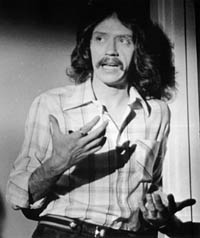
Is today’s youth boom a new development? The Baby Boomers will yelp, “No! Everybody knows that we invented the director-prodigy.” Look:
*Dementia 13: Francis Ford Coppola, 24. If you don’t want to count that, You’re a Big Boy Now was released when Coppola was 27.
*Who’s That Knocking at My Door?: Martin Scorsese, 25.
*Dark Star: John Carpenter (above), 26.
*THX 1138: George Lucas, 27.
*Night of the Living Dead: George Romero, 28.
*The Sugarland Express: Steven Spielberg, 28. If you count the TV feature Duel, subtract 2 years.
*Targets: Peter Bogdanovich, 29.
*Dillinger: John Milius, 29.
*Blue Collar: Paul Schrader, 32.
*Good Times (with Sonny and Cher): William Friedkin, 32.
*Easy Rider: Dennis Hopper, 33.
True, the 70s also revved up veterans like Altman and Ashby, but it was the new generation, we’re always told, who made the difference. Hollywood was run by old men who had brought the studio system to the brink of ruin. The twentysomethings smashed the barricades and made a place for young filmmakers.
It might have seemed that way at the time, but the belief was probably due to a quirk of history. The 1960s and early 1970s were in one respect a unique period in the history of American cinema. During those years, the studios had the widest range of age and experience ever assembled. For the first time in history, it looked like a retirement home.
Look at it this way. In the 1960s, films were being made by directors who had started in the 1950s (e.g., Arthur Penn, Sidney Lumet), as you’d expect. But at the same time there were films by directors who had started in the 1940s: Fred Zinneman, Sam Fuller, Robert Aldrich, Anthony Mann, Nicholas Ray, Vincente Minnelli, Robert Rossen, Robert Wise, Mark Robson, and many others. Furthermore, some of the biggest names of the 1960s were directors who had started in the 1930s, like George Cukor, Carol Reed, George Stevens, Otto Preminger, and Joseph Mankiewicz. More remarkably, the 1960s saw the release of films by masters who had begun in the 1920s, notably Hitchcock, Hawks, Capra, and Wyler.
And believe it or not, several directors who had begun in the 1910s were still active nearly fifty years later. John Ford is the most obvious case, but Chaplin, Alan Dwan, Henry King, Fritz Lang, George Marshall, and Raoul Walsh signed films in the 1960s. When Sidney Lumet celebrates a half-century of directing with the upcoming release of Before the Devil Knows You’re Dead, he will be considered a rare bird in today’s cinema; but in a broader historical context he doesn’t stand alone.
Interestingly, the arrival of the Movie Brats and the blockbuster brought nearly all the veterans’ careers to a halt. No matter what decade an old-timer started, by the mid-1970s he was most likely dead, retired, or making flops. Perhaps the Movie Brats’ sense of Hollywood as a haunted house was created in part by the felt presence of six decades of history.
The studio years
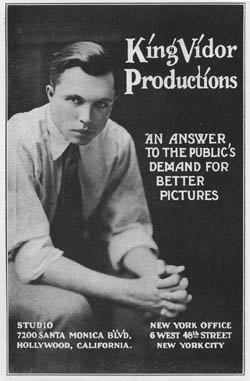
But what about those codgers? At what age did they get started? A look at the evidence suggests that the rise of the twentysomething Movie Brats has plenty of precedents.
The Hollywood studios ran a sort of apprentice system. In the 1920s and 1930s, short comedies and dramas were the era’s equivalent of music videos and commercials—ephemeral material that allowed youngsters to learn their craft. For example, George Stevens started as a cameraman, and at age 26 graduated to directing short comedies. Three years later he made his first feature (The Cohens and Kellys in Trouble, 1933).
Stevens wasn’t atypical. In the 1920s and 1930s, major directors seem to have started as young as they do now. King Vidor began in features at 25, Rouben Mamoulian at 26. Mervyn LeRoy’s first feature was released when he was 27, the same age that Keaton, Capra, and Sam Taylor entered the field. Byron Haskin and W. S. Van Dyke made their debuts at 28. Hawks started at 30, as did Victor Fleming, Lewis Milestone, and Joseph H. Lewis. Clarence Brown signed his first solo feature at 31, the same age as Jules Dassin and George Cukor at their debuts.
Even more remarkable is what went on during the 1910s. As Hollywood was becoming a film capital, it became a playground for twentysomethings. Lois Weber, Alan Dwan (who may have directed 400 movies), James Cruze, Reginald Barker, George Marshall, George Fitzmaurice, Raoul Walsh, and many others directed their first features before they were thirty. (At this point, a feature film could be around an hour. Kristin explains here.) Cecil B. DeMille was on the senior side, having directed The Squaw Man (1914) at age 33. Griffith was then even older of course, but having started in 1908, somewhat earlier than this generation, his authority waned as theirs rose. And he had started directing within my golden zone, at age 33.
Why so many youngsters? In the 1910s, the industry was growing rapidly and it needed a lot of labor. Few people went to college, so teenagers could take low-level jobs at the studios straight out of high school, or even without a secondary education. Moreover, Kristin reminds me that at this time life expectancy was much lower than today; in 1915 a white male on average would live only 53 years. Beginners hurried to get started, and bosses probably found comparatively few oldsters around.
At the other extreme, the World War II years seem to have been a tough time to break in. Anthony Mann, Nicholas Ray, Don Siegel, Richard Brooks, Robert Aldrich, Robert Rossen, and other gifted directors had to wait until their mid- to late thirties before taking the director’s chair in the second half of the 1940s. The 1950s somewhat put the premium on youth again with fresh blood, especially from the East Coast. The most famous instances are Stanley Kubrick (Hollywood feature debut at 28), John Frankenheimer (debut at 30), and John Cassavetes (Hollywood debut at 32).
In short, Hollywood has always favored fresh-faced novices. It’s not surprising. Young people will work exceptionally hard for little pay. They have reserves of energy to cope with a milieu dominated by deadlines, delays, long hours, and rough justice. They are more or less idealistic, which allows them to be exploited but which also infuses the creative process with some imagination and daring. The executives need wisdom, but the talent needs, as they say, a vision.
Some last questions
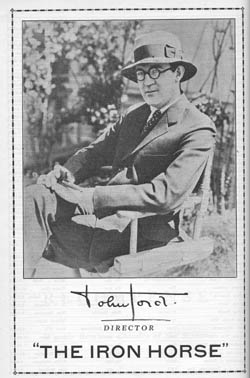
Of course in every era a few older hands start directing features comparatively late. Lloyd Bacon, auteur of the masterpiece Footlight Parade, didn’t make a feature (Broken Hearts of Hollywood, 1926) until he was thirty-seven, after dozens of shorts. Daniel Petrie was forty when his 1960 feature The Bramble Bush was released, and Julie Dash was forty when Daughters of the Dust came out. But you have to look hard to find careers starting this late. Most of the evidence I’ve seen indicates that first features skew young.
First question, then: Is the tendency to seize talent young unique to Hollywood, or is it a characteristic of other popular film industries? My hunch is that it has been a worldwide phenomenon. Eisenstein, who was 27 when he made Potemkin, was treated the oldest of his cohort of Soviet directors; at the other end of that scale were Gregori Kozintsev and Leonid Trauberg, who collaborated on their first film when they were 19! In Japan, Ozu, Mizoguchi, and Kurosawa started directing in their twenties. Michael Curtiz was 30 when he made his first feature, which happened to be Hungary’s first as well. The very name of the French New Wave was borrowed from a sociologist’s catchphrase for postwar twentysomethings. Today, in Europe or Asia, most beginning directors are in their mid-to-late twenties or early thirties. I suspect that everywhere the film industry gobbles up youth, both in front of and behind the camera.
Second, a question for further research. Hollywood hires a lot of first-timers, but how many of them build long-lasting careers? It’s sometimes said that it’s easier to get a first feature than a second.
Third, who’s the youngest director to make a Hollywood feature? The most famous candidate for the Early Admissions program is Orson Welles, who was 25 when Citizen Kane premiered. But on this score at least his old rival William Wyler had him beat. Wyler was 24 when he released his first feature. The fact that his mother was a cousin of Carl Laemmle, boss of Universal, doubtless helped him start near the top.
So is Wyler, at 24, the winner? No. John Ford, Ron Howard, and Harmony Korine were 23 when their first features opened. But wait: Leo McCarey was only 22 when his first feature (Society Secrets) was released in 1921. M. Knight Shyamalan’s first first feature, Praying with Anger, achieved a limited release in 1993, when he was 22.
Yet I think that William K. Howard has the edge. Born on 16 June 1899, he signed two features in late 1921, when he was 22, putting him abreast of McCarey and Shyamalan. But Howard also co-directed a feature that was released on 22 May 1921—about three weeks before his twenty-second birthday. Brett and Sofia and PJ, you are so over the hill.
(Once we move out of the US, the clear winner would seem to be Hana Makhmalbaf. When she was ten, she served as AD for her sister Samira on The Apple, and she signed a documentary feature when she was fifteen. “I used to get excited over the words sound, camera, action. There was a strange power in these three words. That’s why I quit elementary school after second grade at age eight.”)
Finally, how does a little knowledge of film history help us steer hopefuls on the road to Hollywood? It gives us a sharper sense of timing and opportunity. My best revised answer would be this.
Start as young as you can, in any capacity. For directing music videos and commercials, the window opens around age 23. For features, the best you can hope for is to start in your late twenties. But the window closes too. If you haven’t directed a feature-length Hollywood picture by the time you’re 35, you probably never will.
Unless your last name is Bruckheimer, Bullock, Kidman, Cruise, or Bale.
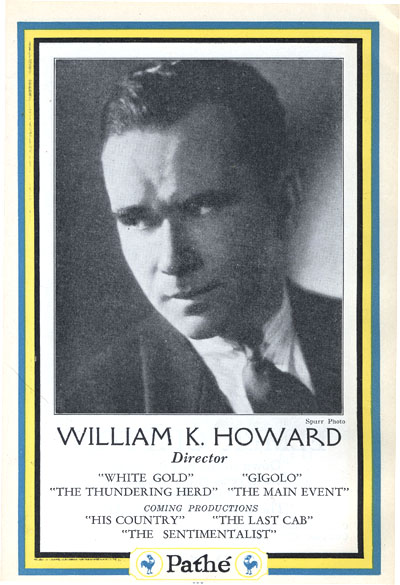
PS 16 Sept 2007: Some corrections and updates: I’m not surprised that my more or less random sampling missed some things. So I’m happy to say that we have new contenders in the youth category.
Charles Coleman, Film Program Director at Facets in Chicago, pointed out that Matty Rich was only 19 when Straight Out of Brooklyn was released in 1991. So my candidate, William K. Howard, is second-best at best.
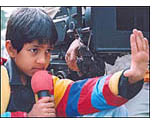 As for Hana Makhmalbaf, she’s been beaten too. Alert reader Ben Dooley wrote to tell me of Kishan Shrikanth, who was evidently ten years old at the release of his feature, Care of Footpath, a Kannada film featuring several Indian stars. Kishan, a movie actor from the age of four, has been dubbed the world’s youngest feature film director by the Guinness Book of World Records. You can read about him here, and this is an interview.
As for Hana Makhmalbaf, she’s been beaten too. Alert reader Ben Dooley wrote to tell me of Kishan Shrikanth, who was evidently ten years old at the release of his feature, Care of Footpath, a Kannada film featuring several Indian stars. Kishan, a movie actor from the age of four, has been dubbed the world’s youngest feature film director by the Guinness Book of World Records. You can read about him here, and this is an interview.
From Australia, critic Adrian Martin writes to point out that Alex Proyas made features before The Crow. “A clear case of Hollywood/ Americanist bias!! (Just kidding.) Proyas had an extensive career in Australia before the USA, and that includes his first, intriguing feature, Spirits of the Air, Gremlins of the Clouds, in 1989. Which puts him around 27 at the time!”
Finally (but what is final in a discussion like this?) over at Mark Mayerson’s informative animation blog, there’s a discussion about animation directors, who tend to be quite a bit older when they sign their first full-length effort. Mark’s reflections and the comments point up some differences between career opportunities in live-action and animated features.
PPS 27 December 2007: Malcolm Mays, currently 17 years old, is shooting a feature under studio auspices. Read the inspiring story here.













